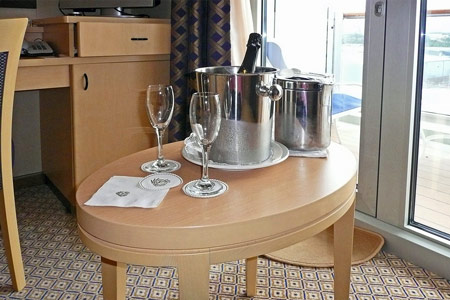|
|
|
|
|
|
|
This is the record of a 13 night cruise taken on board Cunard's
Queen Victoria from Southampton on 17th August 2009.
The party consisted of myself, wife, son and son's friend (both aged 17), in a balcony
cabin and opposing inside cabin. Separate pages show the main ports visited,
with images of the shipping and other transport systems encountered. This is
not primarily a tourist travelogue. This page covers the departure from
Southampton on Monday 17th August.
Overall this was a hugely enjoyable cruise, and the few gripes detailed on
subsequent pages did little to affect this. I found Queen Victoria
to be a comfortable and well laid out ship. However I did not form an
immediate affection for her. This my be due to her newness, but I did form
an immediate attachment to Oriana in her first season, and also to
Aurora on her first completed (but third scheduled) voyage, despite
some misgivings about the open plan passenger flows. Queen Victoria
maintains a similar design style throughout, loosely based on that of the
first Queen Mary. Nothing stands out as being exceptional, but
nothing offends either. She is virtually smoke free as cruise ships
increasingly are, with only the casino as a no-go area if you prefer
breathing air to smoke. The cruise experience has been immeasurably improved
over the last few years for non-smokers, fug-filled rooms a thing of the
past.
The weather throughout was fantastic, with continuous sunshine from our
sailaway past Cowes and the Nab Tower until sunset on the final sea day on
the 29th August. If anything, temperatures were too high, hovering around
the mid to upper 30°s until we made our final
call at Gibraltar when it was a pleasant 28°C.
Only on the return sea days did it drop below 20°C,
although remaining sunny. The only rain was a very brief but heavy thundery
shower as we left Palma.
The cruise was initially advertised as a 12 night voyage. An extra day, and
a call at Livorno (Pisa/Florence) was added by shortening the following
minicruise from 4 to 3 nights. The map below reflects this revised
itinerary. Finally, just 6 days before departure, we were informed that the
Livorno and Civitavecchia calls were being transposed, which obviously saves
fuel, and allows a weekday visit to Rome (more Vatican tour options than a
Sunday?). The itinerary below shows the actual route taken - the map
incorrectly shows Civitavecchia preceding Livorno. This late change caused
us considerable annoyance since we had pre-booked tours of the Colosseum and
Leaning Tower at Pisa. These were only changed after much effort and
additional expense, so Cunard started the cruise with some ill feeling from
us.
Both Queen Victoria and Queen Mary 2 were in port on 17th
August, the former at the Mayflower Terminal and the latter at the new Ocean
Terminal. Queen Victoria was due to depart first at 16:30, but was
late due to a delayed delivery of bottled 'Cunard water'. Queen Mary 2
left first and we never came close to her. Both
Ocean Scene and
Ashleigh R
of Blue Funnel Cruises were
running harbour tours to see the departure of the two Queens. A day of dull
weather brightened up as we left, giving a spectacular view of the
Nab Tower. This weather continued
over the following days, with mid to high 30s and blue skies every day, but
visibility remaining good. This was too hot to do much walking in many of
the ports.
I
An initial problem was that despite booking two adjacent cabins
simultaneously with Cunard we were allocated different tables for dinner.
This could not be rectified for the first evening, but we were promised a
change for the second night. However, we all enjoyed the company on our
separate two tables and our son decided that they preferred their existing
table rather than risk a change of companions.
I also had 120 free minutes of internet access as a Cunard Gold Club member,
but the internet service was appallingly slow - quite the worst speeds
encountered in all my years of cruising. Theoretically I could have wi-fi
access in the cabin, bit not within my 120 free minutes. By day 5 I had
used only 6 of my free minutes since I could not access any websites on
numerous attempts. The ship is apparently being re-cabled (on a ship less
than 2 years old?) but this will not be completed until September. With a
crucial Ashes match in progress it was very irritating, plus I could not
upload any of these web pages as they were completed as I have always been
able to do in the past on P&O, Princess, Celebrity or RCI ships, and even on
the QE2.
|
|
| |
|
|
Day 1: 17th August - Southampton Departure
Red Jet 4
IMO number: 9295854 - Name of ship: RED JET 4 - Call
Sign: VQII3 - Gross tonnage: 342
Type of ship: Passenger Ship - Year of build: 2003 - Flag: United Kingdom
Red Jet 4 joined the Red Funnel fleet in
2003. She was built by North West Bay Ships Pty Ltd, Margate, Tasmania
(Yard/hull No.: 6)..
The Red Jet 4 passing
Calshot on her way to Southampton,
Photo: © Ian Boyle, 17th August 2009

The Red Jet 4 passing
Calshot on her way to Southampton,
Photo: © Ian Boyle, 17th August 2009
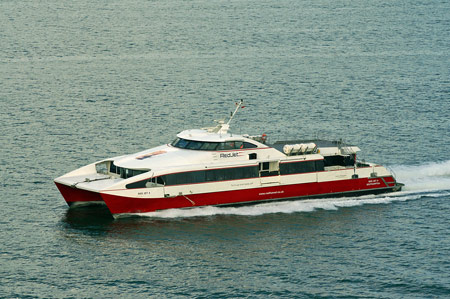
The Red Jet 4 passing
Calshot on her way to Southampton,
Photo: © Ian Boyle, 17th August 2009
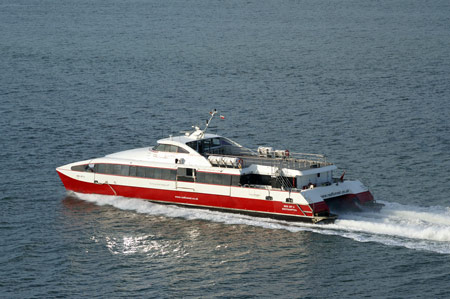
Red Jet 5
IMO number: 8954415 - Name of ship: RED JET 5 - Call
Sign: 2CBD3 - Gross tonnage: 209
Type of ship: Passenger Ship - Year of build: 1999 = Flag: United Kingdom
1999-07 Pequot River Shipworks - New London, Ct Yard/hull No.: PRS-5
Red Jet 5 joined the Red Funnel fleet in
2009. She was built in July 1999 by the Pequot River Shipworks, New London,
Ct (Yard/hull No.: PRS-5) for Bahamas Fast Ferries, with whom she served
until sold to Red Funnel in July 2009.
The Red Jet 5 arriving
at Southampton, with NYK Triton
Photo: © Ian Boyle, 17th August 2009
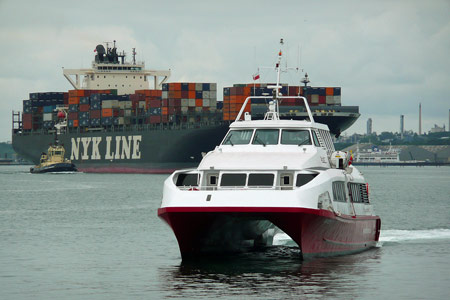
The Red Jet 5 arriving
at Southampton, with Queen Mary 2
Photo: © Ian Boyle, 17th August 2009
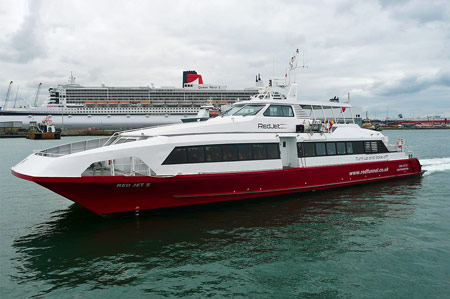
The Red Jet 5 leaving
Cowes
Photo: © Ian Boyle, 17th August 2009
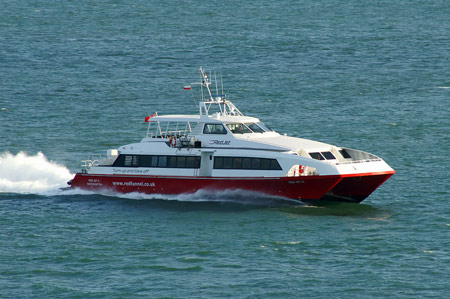
The Red Jet 5 leaving
Cowes
Photo: © Ian Boyle, 17th August 2009
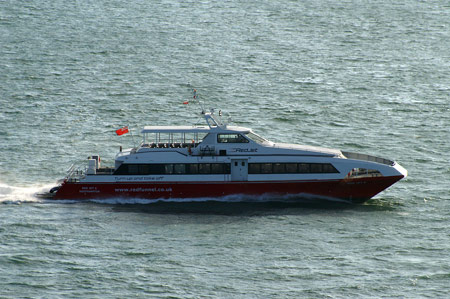
Blue Funnel Cruises - Solent & Wight Line
Blue Funnel Cruises and Solent & Wight Line are
associated companies running cruises in the Solent area. Blue Funnel Cruises
operate the Southampton-based
Ocean Scene and Ashleigh
R. Solent & Wight Line are Cowes-based and run the Wight Scene and
Solent Cat, mainly from Portsmouth. Both were running
The Ocean Scene
Photo: © Ian Boyle, 17th August 2009
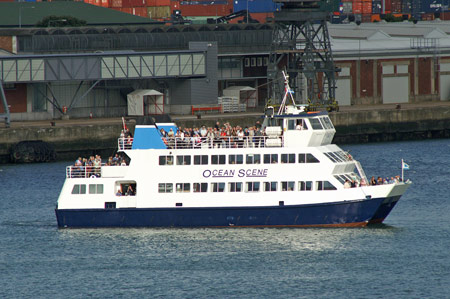
The Ocean Scene
Photo: © Ian Boyle, 17th August 2009
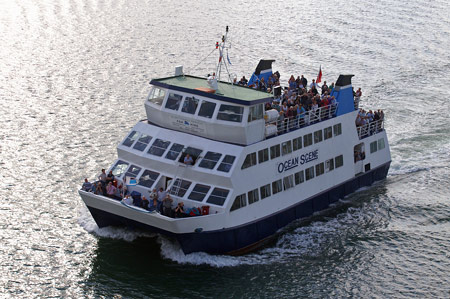
The Ashleigh R
Photo: © Ian Boyle, 17th August 2009

The Ashleigh R
Photo: © Ian Boyle, 17th August 2009
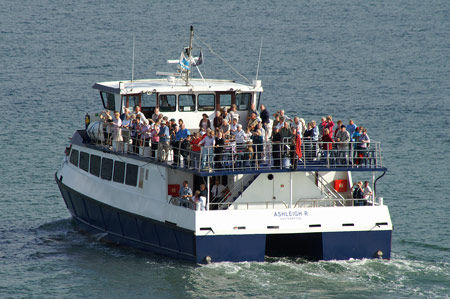
The Solent Cat
returning to Cowes from Portsmouth at the end of her day's cruising
Photo: © Ian Boyle, 17th August 2009
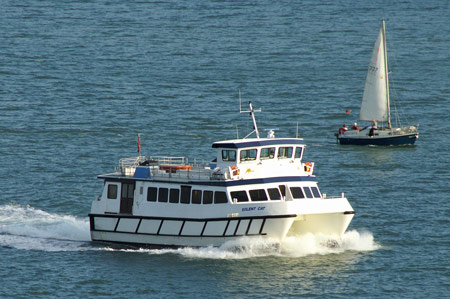
The Solent Cat
returning to Cowes from Portsmouth at the end of her day's cruising
Photo: © Ian Boyle, 17th August 2009
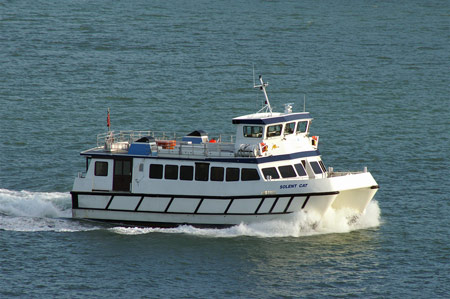
The Solent Cat
returning to Cowes from Portsmouth at the end of her day's cruising
Photo: © Ian Boyle, 17th August 2009
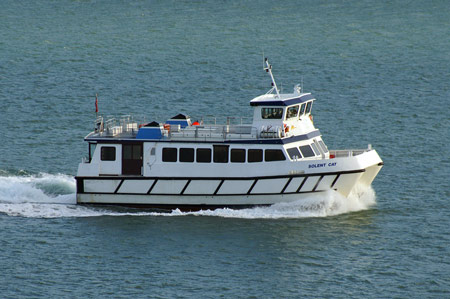
Warsash is a village situated at the mouth of the
River Hamble, west of the area known as Locks Heath. Boating plays an
important part in the village's economy, and the village has a sailing club.
It is also home to the Warsash Maritime Academy, part of Southampton Solent
University, which provides training for merchant navy officers from around
the world.
The village of Warsash on the
River Hamble
Photo: © Ian Boyle, 17th August 2009
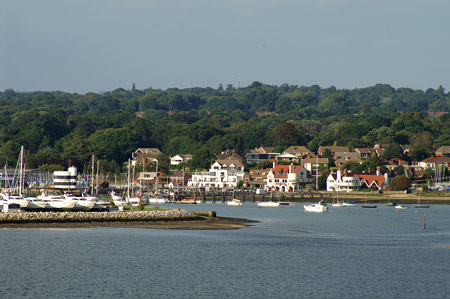
The village of Warsash on the
River Hamble
Photo: © Ian Boyle, 17th August 2009
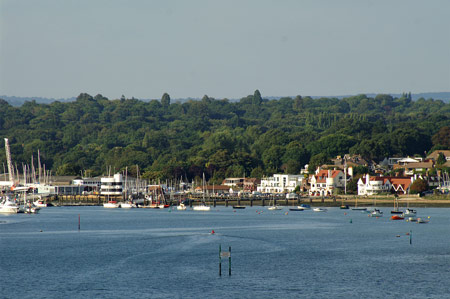
Calshot Spit is a one-mile long sand and shingle bank, located on the
southern bank of the open end of Southampton Water, on the south coast of
England. At the end of the spit are Calshot Castle (built by King
Henry VIII), an RNLI lifeboat, a Coastguard station, several slipways, a
former Royal Navy and Royal Air Force flying boat station and Calshot
Activities Centre.
Calshot CastleThe castle is a low, circular, stone structure and was armed
with large muzzle-loading guns. Its purpose, when it was built in 1539, was
to protect access to the important harbour at Southampton from seaborne
attack, by France or Spain from the English Channel via the Solent.
Calshot Naval Air Station was originally set up in 1913. Its choice as a
location for operating flying boats is clear: the landing area is sheltered
by land on the three sides of Southampton Water and by the Isle of Wight,
several miles away, on the fourth side. In 1929 and 1931, Calshot was the
venue for the Schneider Trophy, an international air race for seaplanes. The
site is now used as a base for the RNLI, yachts and HM Coastguard. The
hangars are home to Calshot Activities Centre and house indoor climbing
walls, artificial ski slopes and a velodrome.
Calshot Spit, with Calshot
Castle, coastguard tower and ex-WW2 seaplane and flying boat hangers
Photo: © Ian Boyle, 17th August 2009
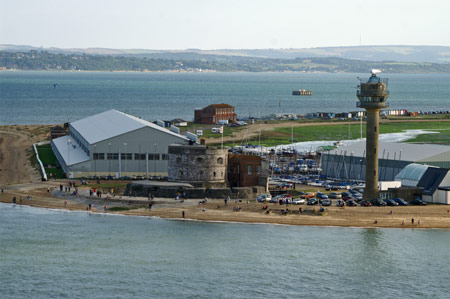
Calshot Spit RNLI station, jetty
and lifeboat
Photo: © Ian Boyle, 17th August 2009
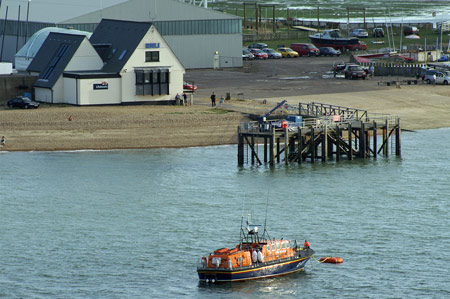
Calshot Castle and RNLI lifeboat
Photo: © Ian Boyle, 17th August 2009
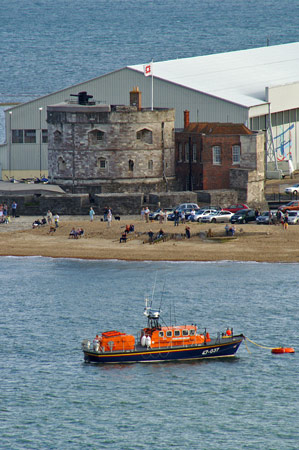
Calshot Spit, with an ex-WW2
seaplane hanger, beach huts and the Isle of Wight in the background
Photo: © Ian Boyle, 17th August 2009
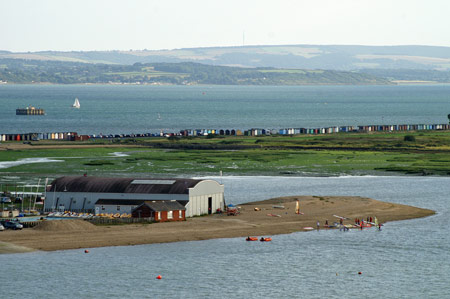
After rounding Calshot Spit, we passed the yachting centre of Cowes, with
its new jetty on the site of the earlier small pier.
Cowes, showing the new jetty on
the site of the old pier
Photo: © Ian Boyle, 17th August 2009
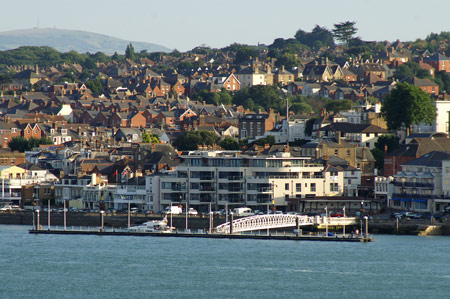
Normandie Express
IMO number: 9221358 - Name of ship: NORMANDIE EXPRESS - Call Sign: FMIH -
Gross tonnage: 6581
Type of ship: Passenger/Ro-Ro Cargo Ship - Year of build: 2000 - Flag:
France
Normandie Express
approaching Portsmouth
Photo: © Ian Boyle, 17th August 2009
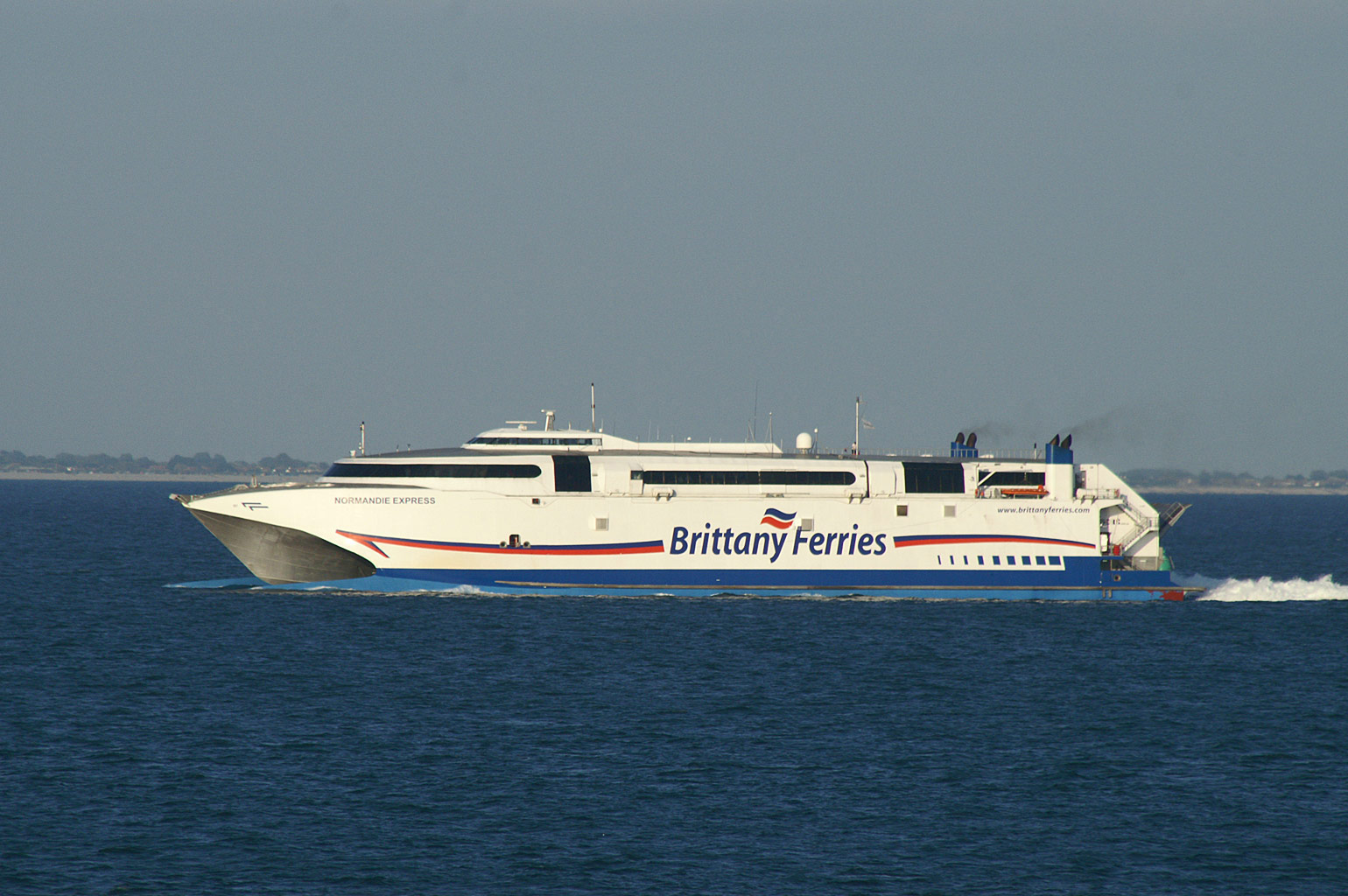
Normandie Express
approaching Portsmouth
Photo: © Ian Boyle, 17th August 2009

Normandie Express
approaching Portsmouth
Photo: © Ian Boyle, 17th August 2009
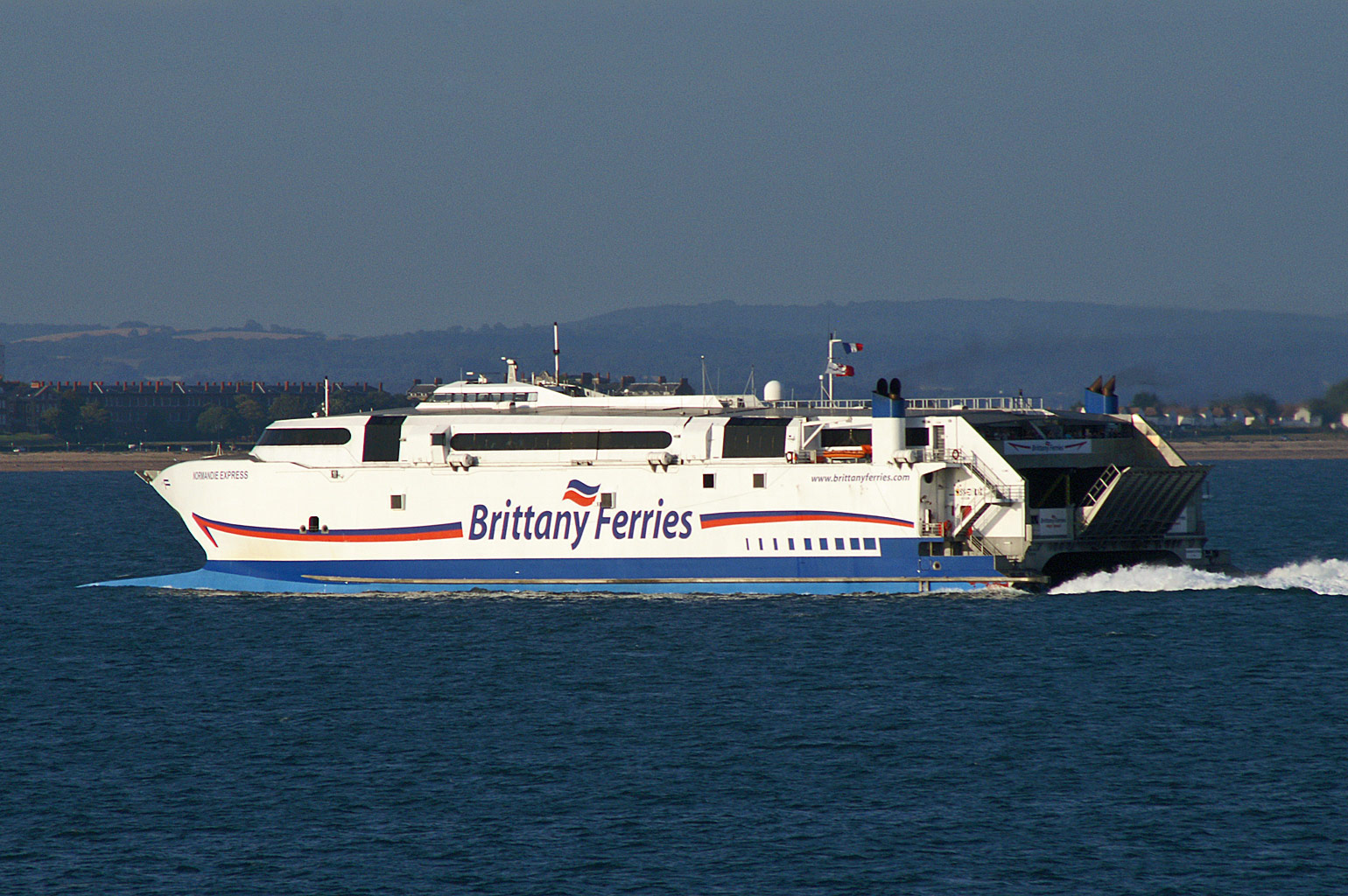
APL Russia
IMO number: 9358761 - Name of ship: APL RUSSIA - Call Sign: C6XF2 - Gross
tonnage: 86692
Type of ship: Container Ship - Year of build: 2008 - Flag: Bahamas
APL Russia passing the
Nab Tower
Photo: © Ian Boyle, 17th August 2009
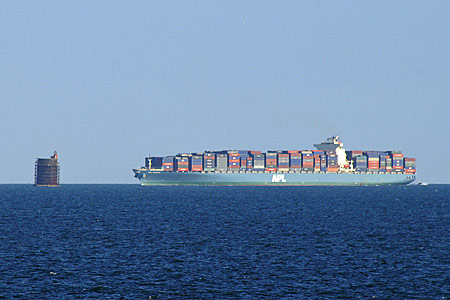
APL Russia of American
President Lines
Photo: © Ian Boyle, 17th August 2009
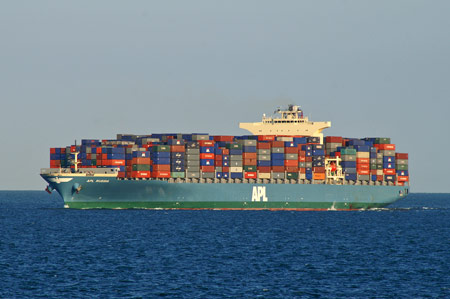
APL Russia of American
President Lines
Photo: © Ian Boyle, 17th August 2009
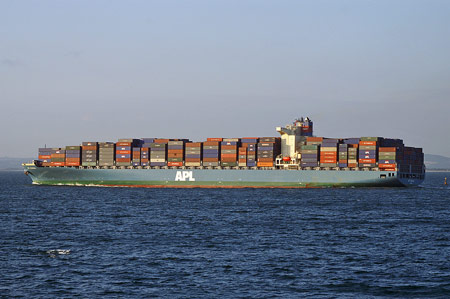
Nab Tower
Nab Tower Lighthouse - Position 50° 40'.05 N 00°
57'.07 W
We passed the Nab Tower off the Isle of Wight at
19:30. This was the best view I have had of this ex-WW1 fortification.
The Nab Tower is a tower planned for anti-submarine protection in the
Straits of Dover in World War I. It was sunk over the Nab rocks east of the
Isle of Wight to replace a lightship after the war, and is a well known
landmark for sailors in the Solent.
During the First World War the British Admiralty designed eight towers code
named M-N that were to be built and positioned in the Straits of Dover to
protect allied merchant shipping from German U-boats. Designed by civilian
G.Menzies, the towers were to be linked together with steel nets and armed
with two 4" guns with the idea of closing the English Channel to enemy
ships. However by the end of the war in 1918 only one had been completed, at
the cost of one million pounds, and was located at Shoreham Harbour,
awaiting deployment. One other part-built structure was dismantled but there
remained a 92 foot tall metal cylinder sitting on a raft of concrete. In
1920 the tower was towed by two paddle tugs to the Nab rock, a rock in the
deep-water approach to the eastern Solent and previously marked by a
lightship. Buoyancy was provided by the honeycomb construction of the
concrete base, creating 18 water-tight compartments. When these were
flooded, the structure sank and settled to rest at an angle of 3 degrees
from vertical towards the northeast - a characteristic tilt which is obvious
to this day.
It was manned as a lighthouse, and during World War II it provided some
defence to the Solent approach, and shot down several aircraft. The
lighthouse is still functional but since 1983 it has been unmanned, operated
by
Trinity House (www.trinityhouse.co.uk). In November 1999 the Nab was hit
by a freighter , the Dole-America, carrying a cargo of bananas and
pineapples. The ship was badly damaged and only avoided sinking by being run
aground. The base of the tower suffered superficial and internal damage.
Damage was repaired in 2001
(www.wikipaedia.com).
The Nab Tower, showing its
pronounced lean from this angle
Photo: © Ian Boyle, 17th August 2009
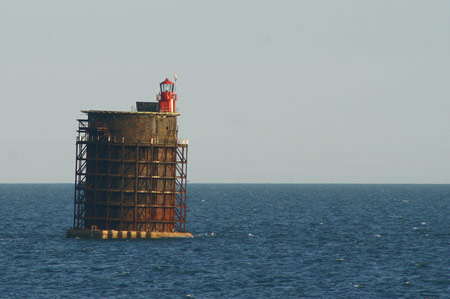
The Nab Tower
Photo: © Ian Boyle, 17th August 2009
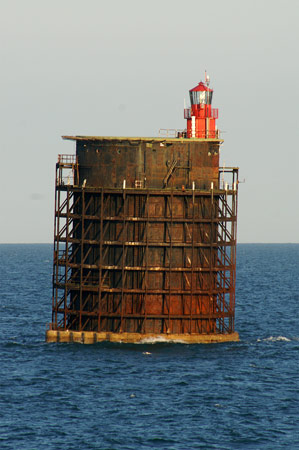
The Nab Tower
Photo: © Ian Boyle, 17th August 2009
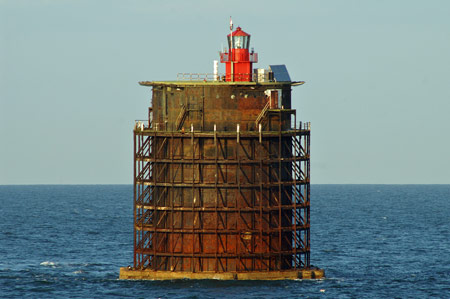
looking back to the Nab Tower
with the UK mainland (Hayling Island?) in the background
Photo: © Ian Boyle, 17th August 2009
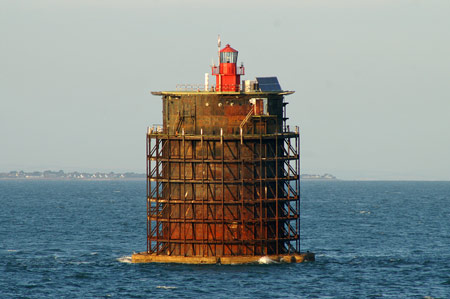
Queen Mary 2 passing
one of the Solent Forts
Photo: © Ian Boyle, 17th August 2009
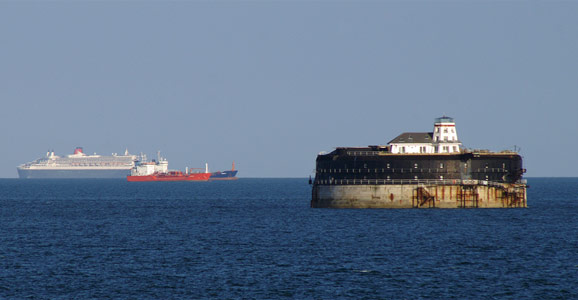
Queen Mary 2 ahead of
us passing anchored shipping off the Isle of Wight
Photo: © Ian Boyle, 17th August 2009
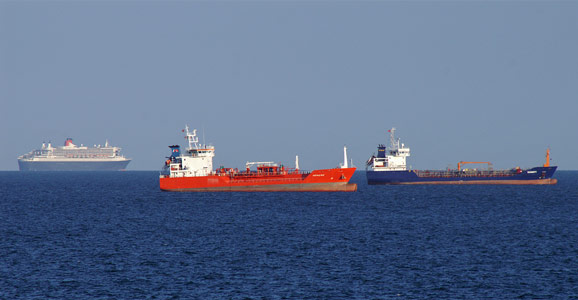
Queen Mary 2 ahead of
us off the Isle of Wight
Photo: © Ian Boyle, 17th August 2009
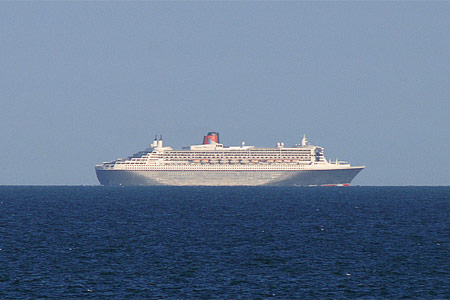
Name of ship: QUEEN VICTORIA - IMO number: 9320556 -
Call Sign: GBQV = Gross tonnage: 90049
Type of ship: Passenger (Cruise) Ship - Year of
build: 2007 - Flag: United Kingdom
Queen Victoria deck 9
looking fowards to deck 10
Photo: © Ian Boyle, 17th August 2009
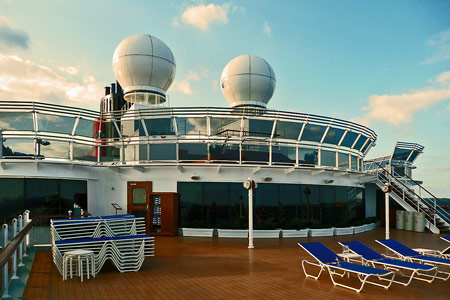
Queen Victoria rounding
Calshot with Cowes, Isle of Wight, in the background
Photo: © Ian Boyle, 17th August 2009
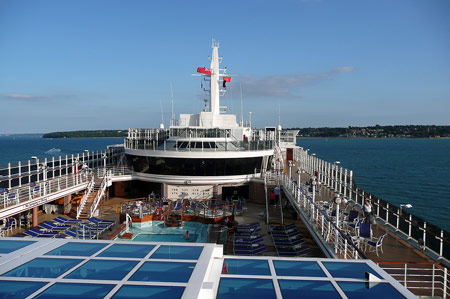
Queen Victoria heading
out to sea with Portsmouth in the distance
Photo: © Ian Boyle, 17th August 2009
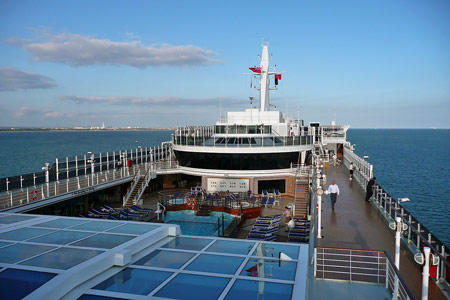
Queen Victoria view
from the promenade deck 3
Photo: © Ian Boyle, 17th August 2009
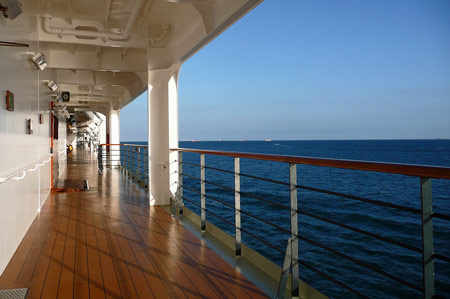
Queen Victoria flags
prior to dropping the pilot
Photo: © Ian Boyle, 17th August 2009
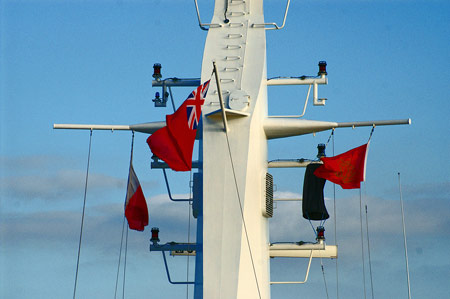
Queen Victoria cabin
6159
Photo: © Ian Boyle, 17th August 2009
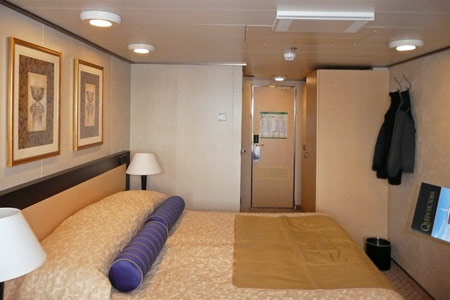
Queen Victoria cabin
6159
Photo: © Ian Boyle, 17th August 2009
